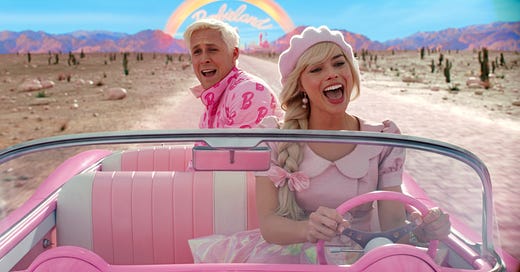‘Barbie’ Review
An extended ad for toys that both demands and rejects the desire to be taken seriously.
AS I WAS WALKING out of my (80 percent full) midday, midweek showing of Barbie, I fired off a text message to a friend: “I just got out of it. It was bad!” Literally as I was hitting send on that message, I heard a girl behind me excitedly say to her mother, “That was great. All of her dresses were so pretty!”
As such, I am tempted to say that this movie is not really for me or for people like me—that I’m an Oppenheimer guy in a Barbie gal’s world—but this movie isn’t really for that little girl either, not really. Simply loving the dresses is almost the opposite of the film’s ostensible point. She didn’t care about the repeated invocation of the patriarchy; I can’t imagine she had any idea what writers Noah Baumbach and Greta Gerwig were getting at when they cracked a joke about Ken reimagining Barbieland as a place where dudes rock and everyone wants to see the Snyder Cut of Justice League. She just wanted to see the pretty outfits and watch the pretty people pretend to be the pretty dolls.
The answer to the question “Who is this movie for?” then, is Mattel, which is desperate to assure progressive-minded millennial working moms (for whom more of the humor will land) that Barbie is fine to share with the next generation. And while Gerwig (who also directed) and Baumbach have attempted to inoculate themselves from the critique that Barbie is nothing but a two-hour-long advertisement for a seven-billion-dollar toy company by highlighting the contradictions inherent in Barbie—Is it empowering because it shows little girls they can be anything? Or disempowering because it emphasizes impractical physical perfection? Does any of this matter given the continued tension women feel between work and home, personal and professional lives?—the fact remains that this is nothing but a two-hour-long advertisement for a seven-billion-dollar toy company.
A seven-billion-dollar toy company currently contemplating major motion pictures for Uno (the card game) and the Magic 8 Ball (the magic 8 ball) on the back of the success of this movie, it should be noted.
But is it any good?
Well, as my text message slyly foreshadowed, the answer on my end is “not really, no.” The story of Barbieland’s descent into a patriarchal nightmare following Barbie (Margot Robbie) and Ken’s (Ryan Gosling) trip to the real world to discover why, precisely, Margot’s Stereotypical Barbie (as opposed to President Barbie [Issa Rae] or Physicist Barbie [Emma Mackey]) is suffering from inescapable thoughts of death fails at the most basic level of prompting laughs. This is a mild problem for a film that is ostensibly a comedy. The jokes just simply didn’t land for me, though I will admit to being amused by a number of the performances.
Here’s the weird thing about Barbie: The best performances—which is to say, the funniest performances—are almost uniformly delivered by men. Ryan Gosling commits with gusto to the bit of himbo with the emotional intelligence of a four-year-old, excitedly looking for books about trucks in a library in the real world or grimacing with frustration when other Kens (like Simu Liu’s iteration of the doll) earn the attention of “his” Barbie. Gosling never fails to give it his all, whether that “all” consists of snobbishly saving jazz music in La La Land, coldly stomping criminals to death in Drive, or showing childlike excitement in being acknowledged by literally anyone for any reason in Barbie.
Similarly amusing is Will Ferrell as the CEO of Mattel; I’ve missed his rubbery appearance and lurching body movements over the last decade or so. He doesn’t really have many “jokes,” per se, but his mere presence is enough to ensure a smile or two. The funniest of the Barbies is undoubtedly Kate McKinnon’s Weird Barbie (representing the Barbies that get played with “too hard,” she has short-cropped hair and marker on her face), but again, less because she delivers satisfying punchlines to proper setups and more because she’s quite good at making silly faces.
The one thing Barbie absolutely has going for it is a sense of place, a sense of difference: The design of “Barbieland” is amusingly garish, both before and after the revolt by the Kens. In a world of CGI mush, Barbie stands out by, at the least, being different. (The irony of Barbie being celebrated for its individuality should not be lost on any of us, and Hollywood writ large should really think long and hard about how we got to this point.)
The good news for fans of Barbie and Barbie alike is that this mostly negative review will do precisely nothing to diminish the film’s gargantuan success: It is, implacably and irresistibly, sweeping the globe just like its plastic predecessor.






